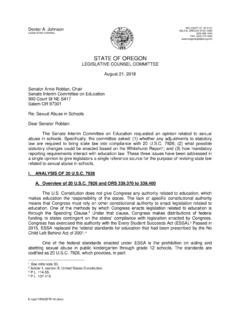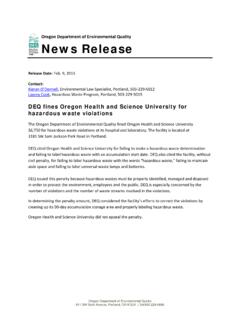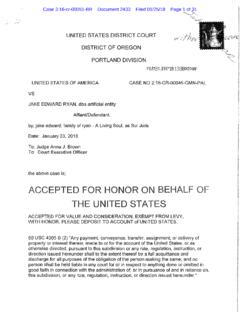Transcription of Portland General Electric Decarbonization Study: Summary ...
1 Portland General Electric Decarbonization Study: Summary of Draft Findings Draft Presented To: PGE Integrated Resource Planning Roundtable Meeting Presented By: Gabe Kwok and Ben Haley February 14, 2018 Agenda Draft page 2 Study Purpose and Scope Assumptions and Approach Scenarios Results Energy Economy Electricity System Study Conclusions Study Purpose and Scope Draft page 3 Motivation Draft page 4 Decarbonization Timeline 75% 2050 2020 2025 2035 2040 10% 40% Oregon GHG Emissions Reductions Goals (below 1990 levels) 20% 50% RPS Requirement (SB 1547) Eliminate all coal from electricity supply (SB 1547) 10 percent reduction in carbon intensity of transportation fuels 100 percent renewable electricity 100 percent clean energy City of Portland and Multnomah County Goals 2030 Customer and stakeholder feedback, alongside a broad spectrum of goals and policies at all levels, is driving an interest in how to achieve economy-wide Decarbonization Local State Clean Fuels Program More stringent targets discussed in recent cap-and-trade legislation Purpose Draft page 5 Portland General Electric (PGE) commissioned EER to undertake an independent study exploring pathways to deep Decarbonization for its service territory First deep Decarbonization study for a utility service territory Questions posed: What are the opportunities and challenges to achieve economy-wide deep Decarbonization ?
2 What are the implications on the electricity sector? Approach We designed and evaluated three future energy scenarios that achieve steep reductions in energy-related CO2 emissions Deep Decarbonization Energy Economy Electricity System Scope Draft page 6 Geography Energy Types GHG Emissions PGE service territory All energy types (gasoline, hydrogen, etc.) Energy-related CO2 (combustion of fossil fuels) Non-energy CO2 (ex., ind. process emissions) Non-CO2 GHGs (ex., CH4 and N20) N/A Rest of Oregon Interpreting Results: What the Study Is and Is Not Draft page 7 What the Study Is Independent analysis exploring credible and plausible future energy scenarios Study is based on scenario (what-if) analysis Scenario design is a user input Scenarios outline potential sources and demands for energy types over time Results illustrate different approaches to achieve deep energy-related CO2 emissions reductions Provides insights into how economy-wide change affects electricity planning and operations What the Study Is Not Scenarios are not a forecast of the future We are not predicting future outcomes or assigning probabilities to scenarios Scenarios are not prescriptive We are not recommending specific pathways Scenarios included in the study are not exhaustive Thousands of plausible alternatives exist Scenarios do not reflect PGE s business plan or future resource acquisitions Study s modeling approach and results do not replace existing tools or processes used in IRP, cost-effectiveness evaluation, etc.
3 Study Emissions Targets Draft page 8 Context is Oregon s on-going GHG cap-and-trade discussions 45% reduction below 1990 levels by 2035 80% reduction below 1990 levels by 2050 Applied emissions reductions only to energy CO2 Allocated state-wide budget to PGE service territory using its share of state s population (45-47% of total) PGE service territory s carbon budget million metric tons (MMT) by 2035 MMT by 2050 Between 1990-2050, per capita energy CO2 emissions decrease from tCO2 to tCO2/person GHG Policy 2035: 45% below 1990 levels 2050: 80% below 1990 levels Emissions Types Energy CO2 only State-to-Service Territory Allocation Population-based PGE Service Territory Carbon Budget 2035: MMT CO2 2050: MMT CO2 Study Approach and Assumptions Draft page 9 What are Pathways? Draft 10 Pathway: Plan or blueprint to achieve deep Decarbonization of the energy system Modeling Approach Draft page 11 EnergyPATHWAYS model Economy-wide energy model that tracks all energy infrastructure, including its demand, emissions and costs Characterizes rollover of infrastructure over time Estimates energy demand from the bottom-up Approach to reduce emissions Specify new low-carbon and efficient infrastructure to replace retiring infrastructure and meet growth in energy service demand Model and approach have been used to analyze deep Decarbonization for the , Washington State and other jurisdictions 20152050 QuantityExisting energy infrastructure Need for new energy infrastructure Growth in demand for energy services Energy Infrastructure (includes energy supply and distribution equipment, buildings and end-use equipment)
4 Today 2050 EnergyPATHWAYS Electricity Dispatch Draft page 12 Bottom-up load shape Accounts for electrification Hourly electricity dispatch Thermal resources Dispatchable hydro resources Energy storage Flexible end-use demand Automated load shifting Examples: smart EV charging and water heating Flexible Electric fuel production Load from electrolysis to produce hydrogen and power-to-gas facilities to produce SNG Illustrative Dispatch Key Assumptions Draft page 13 Consistent activity levels Population and economic activity continue to grow Deliver the same level of energy services Natural stock rollover Energy infrastructure and equipment is replaced at the end of its natural life There are no early retirements Realistic technology deployment Use commercial or near-commercial technologies Power system reliability Hourly dispatch to ensure adequate capacity Environmental sustainability Limit the supply of biomass for energy use Bioenergy for Liquid Fuels and Pipeline Gas Draft page 14 Biomass is key to deep Decarbonization due to its versatility Can directly replace fossil fuels
5 Supply of net-zero carbon biomass is scarce Source for availability and cost of sustainable biomass is DOE s 2016 Billion-Ton Report Assumption Implication PGE service territory s allocation of net-zero biomass is its population-weighted share of national supply Biomass limit is million dry tons (MDT), which is ~450 million gallons diesel fuel Biomass feedstock is net-zero carbon Biofuels have very low emissions rates, with some emissions from non-bioenergy use in conversion/refining Other jurisdictions in the pursue similar biomass-related actions Cost of producing and consuming biofuels reflects movement up the supply curve Data Sources Draft page 15 Category Source(s) Electricity Resource Technologies PGE Integrated Resource Plan (DNV GL) NREL Annual Technology Baseline 2017 EIA Form 923 End-Use Technologies Input data for EIA s National Energy Model System (NEMS) used to produce Annual Energy Outlook (AEO) NREL Electrification Futures Study: End-Use Electric Technology Cost and Performance Projections Existing Building Stock PGE Residential Appliance Saturation Study Northwest Energy Efficiency Alliance (NEEA) Residential and Commercial Building Stock Assessment reports Fossil Fuel Prices EIA AEO 2017 Miscellaneous System load profiles: FERC Form 714 Oregon vehicle miles traveled: 2017 Oregon Highway Cost Allocation Study Population projection: Oregon Office of Economic Analysis Bioenergy supply cure.
6 DOE 2016 Billion-Ton Report Compiled data from recent publicly-available sources Scenarios Draft page 16 Overview Draft page 17 Designed three energy scenarios that transition towards a low carbon future These scenarios are referred to as deep Decarbonization pathways Key objective of scenario design is to reflect broad range of outcomes for the electricity system Also developed a Reference Case to compare the three pathways against Today 2050 energy futures Scenarios Draft page 18 Reference High Electrification Low Electrification High DER A continuation of current and planned policy, and provides a benchmark against the deep Decarbonization pathways Fossil fuel consumption is reduced by electrifying end-uses to the extent possible and increasing renewable electricity generation Greater use of renewable fuels, notably biofuels and synthetic Electric fuels, to satisfy energy demand and reduce emissions Distributed energy resources proliferate in homes and businesses, which also realize higher levels of electrification Electricity Resource Assumptions Draft page 19 Values by 2050 Unless Specified Otherwise High Electrification Low Electrification High DER Electricity Supply Coal Boardman ceases operations by end of 2020; Colstrip 3&4 out of resource mix by 2035 Gas Maintain current fleet Hydro Extend projected hydro contracts through 2050 (933 MW); additional 23 MW of small hydro Geothermal 500 MW addition Utility-scale Wind and Solar PV 75% electricity generation; includes onshore wind in PNW and Montana & solar PV in central OR.
7 MW varies with load requirements 67% electricity generation BTM Solar PV 405 MWac 2,550 MWac Balancing Resources Energy Storage Proposed energy storage resources (36 MW / 160 MWh) 1,000 MW of bulk 8-hour storage No additional 2,550 MW of dist. 6-hr storage Flexible Electric Fuel Loads Excluded Hydrogen (H2) electrolysis & power-to-gas (P2G) production facilities Excluded Flexible End-use Loads Portion of Electric load from select end-uses is flexible (ex., smart EV charging and water heating) Capability varies depending on the level of end-uses that are electrified Summary of Key Scenario Assumptions Draft page 20 Primary Technology or Approach by 2050 High Electrification and High DER Low Electrification Energy Supply Pipeline Gas No change Decarbonized with renewable natural gas (RNG), hydrogen (H2) and synthetic natural gas (SNG) Liquid Transportation Fuels Renewable diesel and jet fuel Renewable diesel and jet fuel Buildings Space Conditioning Air source heat pump High efficiency gas furnace High efficiency air conditioner Water Heating Heat pump water heater High efficiency gas water heater Lighting LED LED Other Appliances (clothes washer, refrigerator, etc.)
8 Best available technology Best available technology Industry Process Heat Partial electrification No change Transportation Passenger Vehicles 90% battery Electric vehicle (BEV); 10% plug-in hybrid Electric vehicle (PHEV) 90% battery Electric vehicle (BEV); 10% hydrogen fuel cell vehicle (HFCV) Freight Trucks 50% Electric 50% hybrid diesel truck 50% Electric 50% liquefied & compressed gas (LNG/CNG) Results Energy Economy Draft page 21 Energy-related CO2 Emissions Draft page 22 Million metric tons 2050 GHG Target All three pathways reduce emissions below 2050 CO2 target Reference emissions decrease until 2035, but fall substantially short of 2050 carbon target Includes emissions for the entire energy system and is not limited to power generation Final Energy Demand Draft page 23 Trillion Btu (TBtu) Overall energy demand decreases in all pathways (25 to 33% below Reference by 2050) Expanded role for electricity in all pathways Gasoline and diesel consumption heavily reduced across pathways LNG and CNG in freight trucks plays a key role Note.
9 Other includes final energy types such as jet fuel, liquefied petroleum gas (LPG), biomass, steam, etc. Final energy: energy used in the delivery of services such as heating or transportation and excludes energy consumed in converting to other forms of energy 44%25%7%0%20%40%60%20502017% of Final EnergyThree Pillars of Deep Decarbonization Draft page 24 8414705010015020020502017 CO2/MWh54%25%0%20%40%60%20502017% of Final Energy9314705010015020020502017 CO2 CO2/MWh8414705010015020020502017 MMBtu/person54%25%0%20%40%60%20502017% of Final EnergyHigh Electrification Electricity Decarbonization Carbon Intensity of Electricity Generation (tonnes CO2 per MWh) Electrification Share of Electricity and Electric Fuels in Total Final Energy (%) Energy Efficiency Final Energy Consumption per Person (MMBtu per person) Low Electrification High DER Synthetic Electric fuels Electricity Three Pillars in Action.
10 Passenger Transportation Draft page 25 High Electrification Pathway Pillar: Electrification Transition vehicles on the road from gasoline-powered internal combustion engine to battery Electric and plug-in hybrid Electric vehicles Pillar: Energy Efficiency 70 percent decrease in energy consumption since battery Electric powertrains are more efficient than an internal combustion engine Pillar: Electricity Decarbonization Charging Electric vehicles on a low carbon electricity grid decreases overall passenger transportation emissions by 95 percent -95% -72% 100% Passenger Transportation Electrification Draft page 26 High Electrification Pathway Our pathways assume 100 percent of vehicle sales are zero emissions vehicles (ZEV) by 2035 90 percent battery Electric vehicle (BEV) in all pathways Remaining 10 percent is plug-in hybrid Electric vehicle (PHEV)













